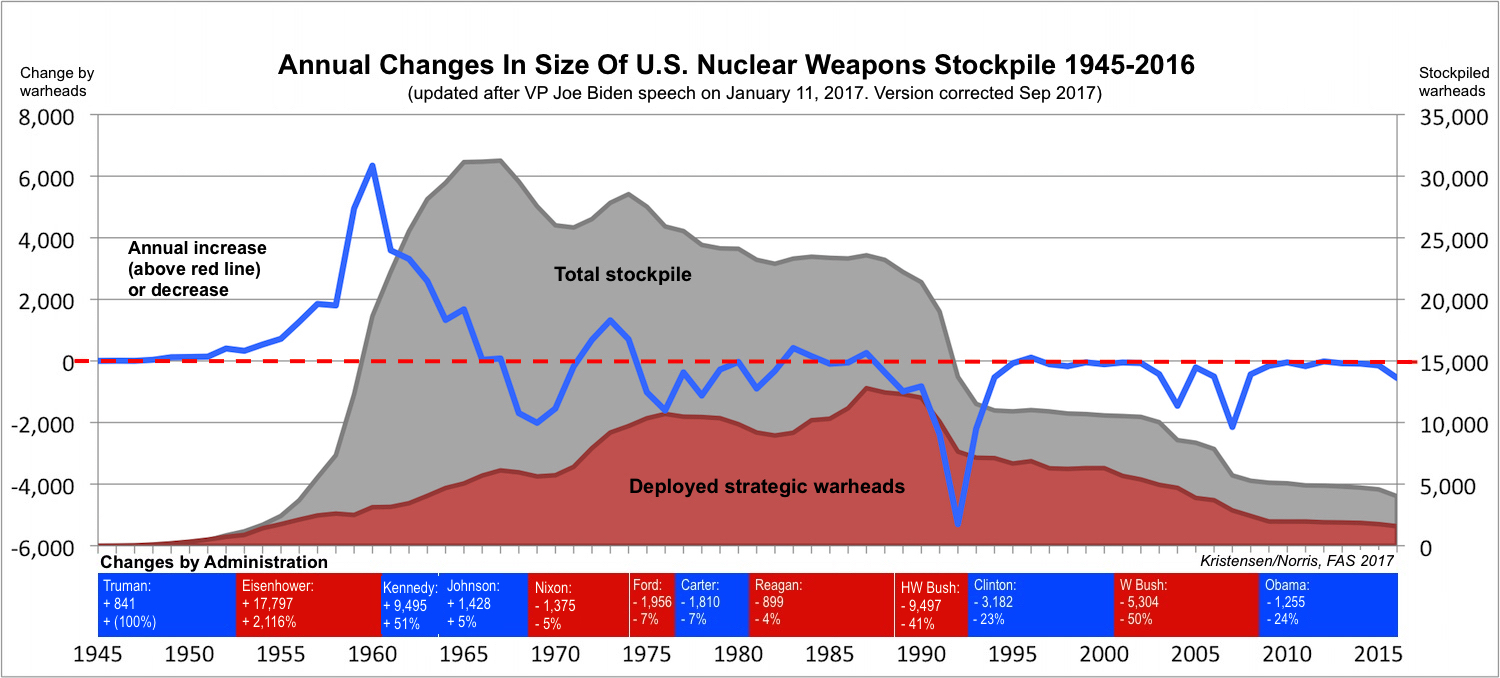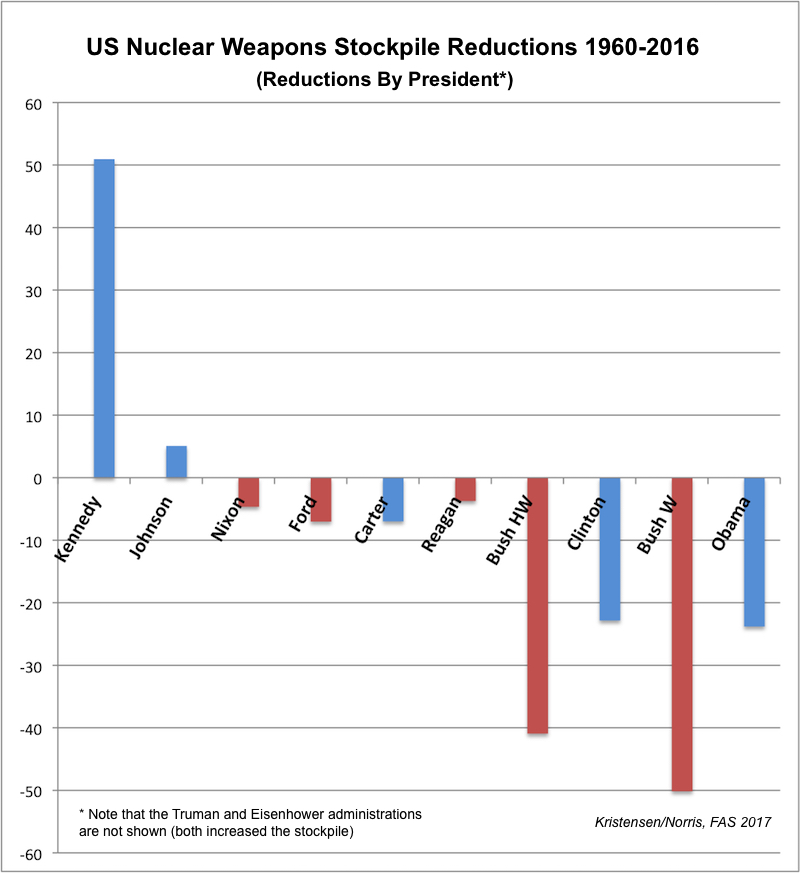
Obama Administration Announces Unilateral Nuclear Weapon Cuts
By Hans M. Kristensen
The Obama administration has unilaterally cut the number of nuclear weapons in the Pentagon’s nuclear weapons stockpile to 4,018 warheads, a reduction of 553 warheads since September 2015.
The reduction was disclosed by Vice President Joe Biden during a speech at the Carnegie Endowment for International Peace earlier today.
This means that the Obama administration during its two terms has reduced the US nuclear weapons stockpile by 1,255 weapons compared with the size at the end of the George W. Bush administration – a number greater than the estimated number of warheads in the arsenals of Britain, China, France, India, Israel, North Korea, and Pakistan combined.
Stockpile Reductions In Context
The Obama administration’s additional unilateral cut shows up as a small dip on the graph of US nuclear weapons stockpile changes since 1945 (see figure below; graph corrected Sep 2017).
Even so, the Obama administration still holds the position of being the administration that has cut the least warheads from the stockpile compared with other post-Cold War presidencies.
Part of the reason for this is that the overall size of the stockpile today is much smaller than two decades ago, so one would expect new warhead cuts to also be smaller. But this is only partially true because the George W. Bush administration cut significantly more warheads from the stockpile than the Clinton administration.
In fact, it is still the case that Republican presidents in the post-Cold War period have cut many more warheads from the stockpile than have Democratic presidents: 14,801 versus 4,437.
Even so, the latest cut means that the Obama administration has managed to surpass (barely) the Clinton administration in terms of how much it reduced the stockpile (24 percent versus 23 percent) (see figure below).
Reducing the Hedge
The administration has not disclosed what types of warheads were cut from the stockpile or what part of it they were taken from. We estimate that the warheads were taken from the inactive reserve of non-deployed warheads that are stored to provide a “hedge” against technical failure of a warhead type or to respond to geopolitical surprises.
The 2013 Nuclear Employment Strategy determined that the hedge was too big and that it was only necessary to hedge against technical warhead failure. That hedge would also serve as a geopolitical hedge. As a result, several hundred hedge warheads were no longer needed.
So the 553 cut warheads probably include excess W76, B61, and B83 warheads that were scheduled to be retired anyway as a result of changes to the nuclear war plans and the ongoing warhead life-extension programs. [Update 011317: In addition to excess W76s, the cut might also include the W84 warhead that previously armed the Ground Launch Cruise Missile. The W84 was retired once but brought back into the stockpile as a potential warhead candidate for the LRSO. But after the W80 was selected as the LRSO warhead, the W84 might have met its doom (House conservatives tried to prohibit dismantlement of the W84 in the FY2017 defense bill but the effort didn’t survive the final cut). Yet there were fewer than 400 W84s produced, so the 553 cut (“almost 500 warheads for dismantlement on top of those previously scheduled for retirement”) would have to include other warhead types as well. Those could potentially also include excess W78 ICBM warheads. Any potential B61s would likely be minimal because they await production of the B61-12.]
The Growing Dismantlement Queue
The cut adds significantly to the large inventory of retired (but still intact) warheads that are awaiting dismantlement. Secretary of State John Kerry announced in April 2015 that the retirement queue included some 2,500 warheads. Vice President Biden announced that the number has since grown to about 2,800 warheads.
Biden also announced that the Obama administration during its eight years in office had dismantled 2,226 warheads. That indicates that about 250 warheads were dismantled in the last year.
The administration has promised that all the warheads that were retired prior to 2009 will be dismantled by 2021 (in reality some warheads already dismantled were retired after 2009). But with the average rate of about 278 warheads dismantled per year during the Obama administration, it will take until 2026 to dismantle the current backlog of retired warheads.
Political and Strategic Implications
The Obama administration must be congratulated on taking additional steps to unilaterally reduce the US nuclear weapons stockpile and improve its nuclear arms reduction legacy.
This will help the US position at the Preparatory Conference for the nuclear Non-Proliferation Treaty (NPT) later this spring and will increase pressure on the other nuclear-weapons states party to the treaty (Russia, China, France, and Britain) to also take new initiatives – even without formal arms negotiations.
The Obama administration also deserves praise for continuing to provide transparency of the US nuclear arsenal. Not only has it disclosed the history of the US nuclear stockpile and provided annual updates. It has also disclosed its warhead dismantlement history and declared how many retired warheads remain in the dismantlement queue. And it has declassified other chapters of the US nuclear history, including the number of nuclear weapons deployed at sea during the Cold War.
This transparency helps facilitate a debate about the history and future of nuclear weapons that is based on facts rather than rumors. Moreover, it helps increase the incentive for other nuclear-armed states to also be more transparent. If Britain and France were also to disclose their nuclear stockpile and dismantlement histories, the three Western nuclear powers would have a significantly stronger position from which to urge Russia and other nuclear-armed states to be more transparent about their arsenals.
At home, the Obama administration’s announcement about the additional nuclear cuts helps shine the light on the Trump administration and what its nuclear policies will be. Some will decry the Obama administration’s unilateral cut as weakening US military strength, but that would be wrong for several reasons.
First, the Obama administration has started a nuclear weapons modernization program that makes the George W. Bush administration pale in comparison.
Second, the cut reflects US military requirements. The Pentagon has long stated that even after the New START treaty is implemented next year, the United States will still have up to one-third more nuclear warheads deployed than is needed to meet US national and international commitments.
Russia currently has a nuclear weapons stockpile of nearly 4,500 warheads but is also reducing its nuclear arsenal (despite a temporary increase in deployed warheads counted under New START). While some commentators are obsessed with US-Russian nuclear parity, the Pentagon seems less interested in numbers and more interested in quality and in 2012 concluded:
The “Russian Federation…would not be able to achieve a militarily significant advantage by any plausible expansion of its strategic nuclear forces, even in a cheating or breakout scenario under the New START Treaty, primarily because of the inherent survivability of the planned U.S. Strategic force structure, particularly the OHIO-class ballistic missile submarines, a number of which are at sea at any given time.”
Instead, the Trump administration should continue the broad outline of the Obama administration’s nuclear policy of gradually but responsibly reducing the numbers and reliance on nuclear weapons while actively seeking to persuade other nuclear-armed states to follow the example.
Additional Information:
- United States nuclear forces, 2017 [Note: this publication was researched before the 2017 stockpile announcement.]
- Global Overview: Status of World Nuclear Forces
This publication was made possible by a grant from the New Land Foundation and Ploughshares Fund. The statements made and views expressed are solely the responsibility of the author.
The FY2026 National Defense Authorization Act (NDAA) paints a picture of a Congress that is working to both protect and accelerate nuclear modernization programs while simultaneously lacking trust in the Pentagon and the Department of Energy to execute them.
While advanced Chinese language proficiency and cultural familiarity remain irreplaceable skills, they are neither necessary nor sufficient for successful open-source analysis on China’s nuclear forces.
Satellite imagery has long served as a tool for observing on-the-ground activity worldwide, and offers especially valuable insights into the operation, development, and physical features related to nuclear technology.
This report outlines a framework relying on “Cooperative Technical Means” for effective arms control verification based on remote sensing, avoiding on-site inspections but maintaining a level of transparency that allows for immediate detection of changes in nuclear posture or a significant build-up above agreed limits.

